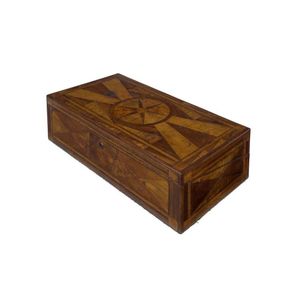Australian Wood Inlaid Document Box, 1850
You must be a subscriber, and be logged in to view price and dealer details.
Subscribe Now to view actual auction price for this item
When you subscribe, you have the option of setting the currency in which to display prices to $Au, $US, $NZ or Stg.
- Chevron Motif - In jewellery, a chevron is a V-shaped pattern or design that is often used to create a bold and striking visual effect, and as a symbol of strength, power and protection.. It is a classic motif used in many different styles of jewellery and can be seen in various forms such as on a ring, earrings, bracelets, and necklaces. It can be created with precious or semi-precious stones, pearls, or enamel. It can be found in different forms such as engraved or inlaid or beaded.
In ceramics the pattern is often used in decorative pottery and porcelain pieces, such as vases, bowls, plates and figurines. The chevron pattern can be created by using different colored glazes or by hand-painting the design onto the piece. It is also commonly found in the form of embossing or intaglio in decorative ceramic objects. This pattern can be seen as a popular design choice in Art Deco and Art Nouveau style of ceramics.
This chevron pattern can also be found in many different types of furniture, such as tables, chairs, chests of drawers, and cabinets. A common place to find chevron pattern is in a herringbone pattern, which is made up of repeating V-shaped patterns. The chevron pattern can be created by using different types of wood, inlaying or by using different colors of stain. It is also commonly found in the form of a veneer. This pattern can be seen as a popular design choice in mid-century modern, Art Deco, and contemporary style furniture. - Rosewood - A dense timber that varies in shade to very light brown to almost black. When rosewood is cut and sanded the colour of the timber will turn black, and after polishing and exposure to daylight, the surface will gradually lighten over time to light brown with black streaks.
The name comes from the odour emanating from the timber when it is planed, sanded or cut.
Rosewood was very popular for use in Victorian furniture in the second half of the 19th century, and at that time most of the rosewood was imported from Brazil. However it also grows in India and Indonesia.
It is used in the sold for chairs and table legs, but for carcase furniture such as side cabinets and bookcases, and for table tops it is always used as a veneer. - Circa - A Latin term meaning 'about', often used in the antique trade to give an approximate date for the piece, usually considered to be five years on either side of the circa year. Thus, circa 1900 means the piece was made about 1900, probably between 1895 and 1905. The expression is sometimes abbreviated to c.1900.
This item has been included into following indexes:
- boxes, function
- boxes, material or decoration - specimen wood boxes 39
Visually similar items

A superb Tasmanian timber writing box, huon pine, musk, cedar, blackwood, myrtle, beefwood, honeysuckle and casuarina, cedar secondary timbers, fitted with slope and drawer compartments, circa 1850, 18 cm high, 61 cm wide, 31 cm deep

A Victorian walnut writing box inlaid with brass and mother of pearl, with original inkwells, interior restored. 14 cm high, 35 cm wide, 24 cm deep

An inlaid Tasmanian timber box, cedar, blackwood, huon pine, celery pine on huon pine carcass, 19th century, 13 cm high, 28 cm wide, 20 cm deep

An outstanding Anton Seuffert New Zealand inlaid jewellery box, the lid decorated with inlaid ferns, clematis and central monogram. The sides with 'Gothic' specimen wood panels. An orange Royal Appointment label underneath, illustrated page 128 'The Seuffe
